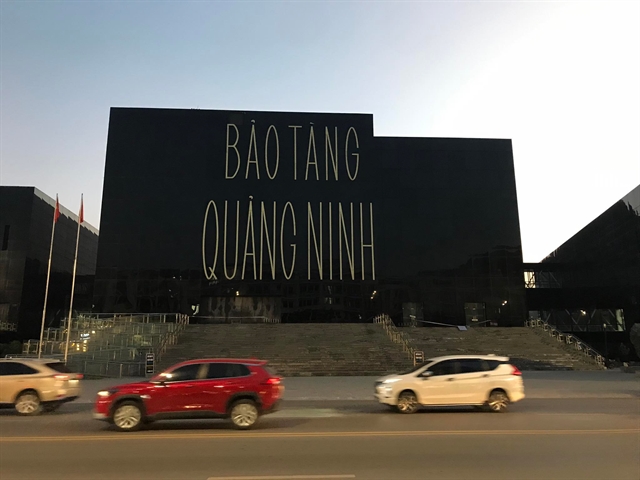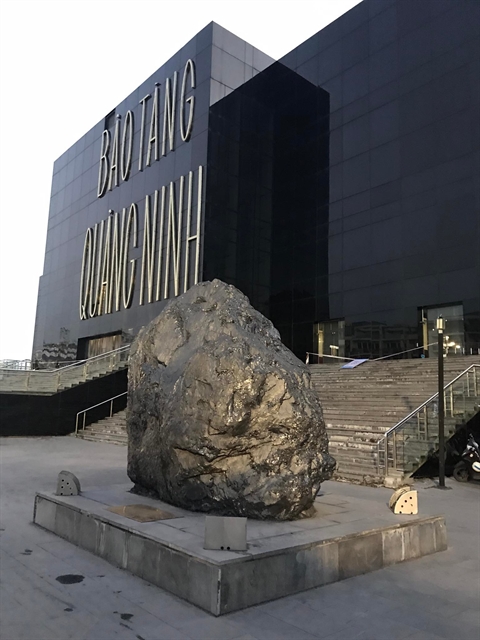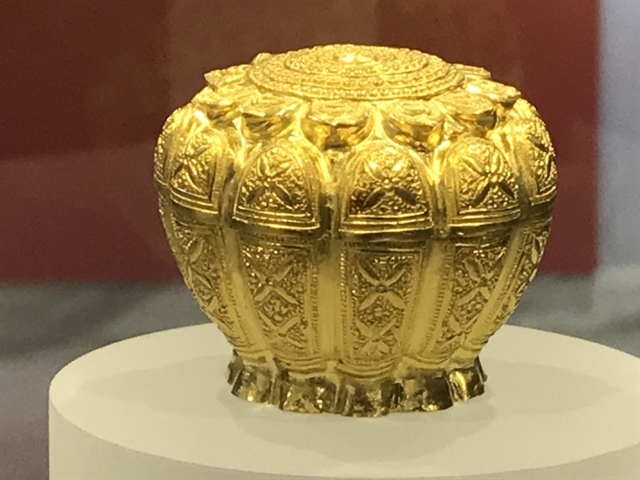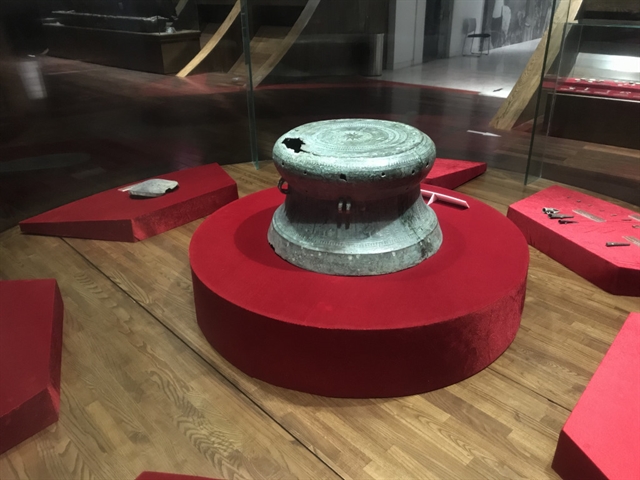 Features
Features

The distinguished architecture of the Quảng Ninh Museum and Library complex has proved a popular draw for visitors of all ages in the northern province. Now that Quảng Ninh has reopened to tourists it is among the places most worth exploring.
By Lê Hương
The distinguished architecture of the Quảng Ninh Museum and Library complex has proved a popular draw for visitors of all ages in the northern province.
Now that Quảng Ninh has reopened to tourists it is among the places most worth exploring.
Located on the October 30 Square on Trần Quốc Nghiễn Road overlooking Hạ Long Bay, the building was inaugurated in October 2013 and covers a total area of 24,000 square metres.
It was designed by Spanish designer Salvador Perez Arroyo, who was inspired by the image of a lump of coal, a mineral found in abundance in Quảng Ninh.

|
| The Quảng Ninh Museum-Library complex is a highlight of Hạ Long City. VNS Photo Vân Từ |
“Simple and elegant - that is my first impression on the complex,” architect Lê Thanh Bình from Hà Nội told Việt Nam News.
“The square formed building covered with black glass brightly lit under the sun reflected with nearby sparkling sea water looks quite modern with the simple characters forming the name of the building,” Bình said.
“The museum’s facade bears a modern look, not ancient like other provincial museums. This explains why it is so popular among young visitors, not only the elderly, who want to understand the history of the region.”
An intact block of coal weighing about 28 tonnes is displayed at the entrance of the building, which has been recorded as the largest block of coal in the country.

|
| A block of coal weighing about 28 tonnes stands at the entrance of the museum. VNS Photo Vân Từ |
“The coal is a factor in the feng shui of the place,” Bình said
The complex was voted as the Building of the Year 2013 at the prestigious annual Ashui Awards hosted by Ashui Vietnam Corporation.
Alluring exhibits
Museum director Kiều Đinh Sơn said the inside exhibitions were particularly alluring to curious visitors.
Gathering 20,000 exhibits, mostly handed down from the initial museum established in 1960, the museum space includes three storeys featuring both basic and distinguished elements of the Quảng Ninh region, which covers mountains, plains and sea.

|
| A visitor on the first floor of the museum. Photo monkeymedia.com.vn |
“Opposite to the outside colour -- black -- the inside main colour of the space is white to highlight the exhibits,” Sơn said.
The first floor highlights the sea and nature, with the standout exhibit being four pillars in the form of mountains emerging from the sea like those seen in Hạ Long Bay.
“The light effects here make me feel as if I were walking in the magnificent bay,” said visitor Đinh Thùy Linh, 28, from Hà Nội.
Each mountain tube is a separate space showcasing the development of the local geology, seabed, fauna, flora and insects.
On the second floor, there are various exhibition spaces, including a replica of a ship, while the first room features various prehistoric objects found throughout the region.
The next room is designed like a jungle, resembling the Đông Triều revolutionary base that was used when fighting French colonialism.
The area for the American war exhibition is shaped like a war plane to remind visitors of the victory of the Vietnamese people and their army over the American air force.
A spiritual cultural space features a Yên Tử Buddhism complex and elements of the Trúc Lâm Zen school.
A replica of the popular Đồng (Bronze) Pagoda on the peak of the Yên Tử mountain range and various valuable antiques are displayed beside a space featuring heritage objects dating back to the Trần Dynasty (1225-1400).
After handing the throne to his son in 1293, King Trần Nhân Tông (1258-1308) led a monk’s life in a cave situated in today’s Ninh Bình Province. In 1299, the royal monk moved to the Yên Tử mountains in Quảng Ninh where he merged three previous Zen schools dating back to the 12th century, founding the Trúc Lâm Zen school.
National treasures
Among the exhibits, the Ngọa Vân – Yên Tử gold box is the only intact item of its kind dating back to the Trần Dynasty.
The box was found by chance nine years ago at a construction site on the road leading to Ngọa Vân Pagoda where King Trần Nhân Tông lived as monk.

|
| The Ngọa Vân - Yên Tử gold box. Photo baoquangninh.com.vn |
In 2015, it was handed over to the museum by the Đông Triều Town authorities. The box looks like a blooming lotus while every petal is carved with the image of a delicate four-petal lime flower surrounded with branches.
The Đầu Rằm ceramic jar is among two special treasures displayed at the museum, according to Sơn. It is believed to have been used in the worship ceremonies of the Phùng Nguyên primitive people (2,000 to 1,500BC).
A bronze drum dating back to the Trần Dynasty is the other valuable treasure of the museum. It bears typical patterns of the dynasty such as lotus, lime and chrysanthemum flowers.
“The object is bestowed with the art of Đông Sơn bronze drums and the decorative art of the Trần Dynasty,” Sơn said. “The object might have been used in worship ceremonies by the Trần royal family.”

|
| The Quảng Chính bronze drum. VNA/VNS File Photo |
A Quảng Chính bronze drum, which dates back to the second or third century BC, is an antique named after Quảng Chính Commune, Hải Hà District, where it was found in 1981 by a local farmer. The drum was handed to the museum in 1983.
“It is the only bronze drum found in Quảng Ninh,” Sơn said. “It has value not only in terms of history but also as an artefact that is evidence of the national sovereignty of this border region.”
It features the Đông Sơn bronze drum style, yet has a number of differences in the decorative patterns, especially in the birds and people rowing, according to Sơn.
Since 2018 when the Đầu Rằm ceramic jar and Ngọa Vân gold box were recognized as treasures, the museum has had a special space to share the objects. However, the preservation task has been hindered due to a lack of specially designed cupboards for the objects, and moisture that could harm the antiques.
“We have asked concerned agencies to invest more so that we can restore the antiques better,” Sơn said.
Provincial pride
The top floor showcases a source of much local pride: coal. An exhibit describes the history and development of the province’s coal mining industry.
President Hồ Chí Minh visited the province seven times. On his visit in 1946, he said: “Our coal mine region is so rich and beautiful. Our miners are so brave.”
Director Sơn said the museum hosted thousands of visitors every year and connected with other heritage sites such as the Bài Thơ (Poem) Mountain, which hosts a poem by King Lê Thánh Tông carved on a stone in 1468 and another by Lord Trịnh Cương in 1729; a 13th century temple dedicated to General Trần Quốc Nghiễn; and Long Tiên Pagoda built at the foot of Poem Mountain in 1941.
Nearby tourist destinations include Hồng Gai Church, and modern landmarks like Hạ Long Recreational Complex Marine Plaza and Vincom Centre Hạ Long.
In normal times, the museum is open throughout the week except the final Monday of each month.
Guides speaking Vietnamese, English and Chinese are available at the museum for groups of fewer than 35 people. VNS




